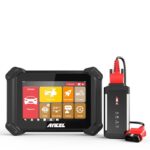Connecting your car to your smartphone via an OBD2 adapter opens up a world of vehicle diagnostics and performance monitoring. The first hurdle many users encounter is pairing their Bluetooth OBD2 adapter with their phone. This process often requires an “Obd2 Pairing Code,” and understanding how to find and use it is crucial. This guide will walk you through the steps to successfully pair your OBD2 adapter and get connected.
Before you begin, ensure you have a Bluetooth-enabled OBD2 ELM327 adapter. Plug the adapter into your car’s OBDII diagnostic socket, typically located under the dashboard on the driver’s side. Turn your car’s ignition to the “ON” position, or start the engine to power the adapter. If your adapter has a power button, make sure it is switched on.
Step #1: Bluetooth Pairing with Your OBD2 Adapter
If you’ve previously paired your adapter with your phone, you can skip to Step #2. Otherwise, you’ll need to establish a Bluetooth connection.
Note: The exact steps for Bluetooth pairing can vary slightly depending on your Android version.
Navigate to your phone’s settings menu and find the Bluetooth settings. Enable Bluetooth and let your phone scan for nearby devices. Your OBD2 adapter should appear in the list of available devices. It’s usually identified by names like “OBDII,” “obd2,” or a brand name such as “Viecar” or “VLink.” It’s important to note that the adapter will not be named after your car brand or something generic like “MY CAR.”
